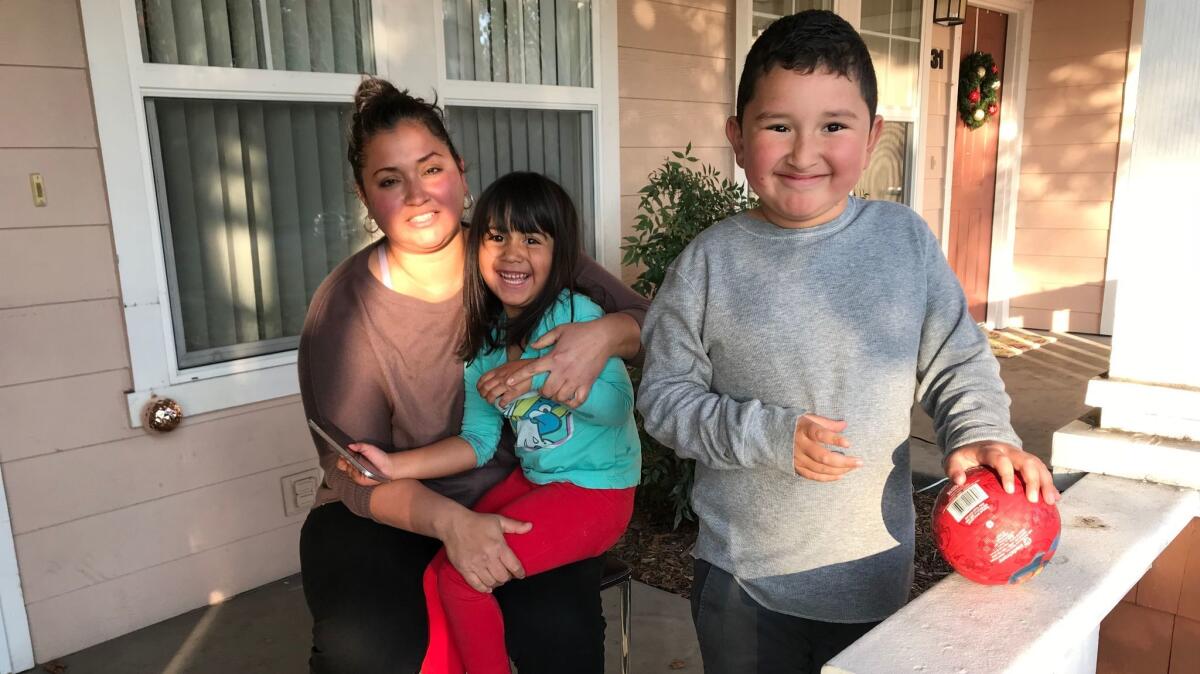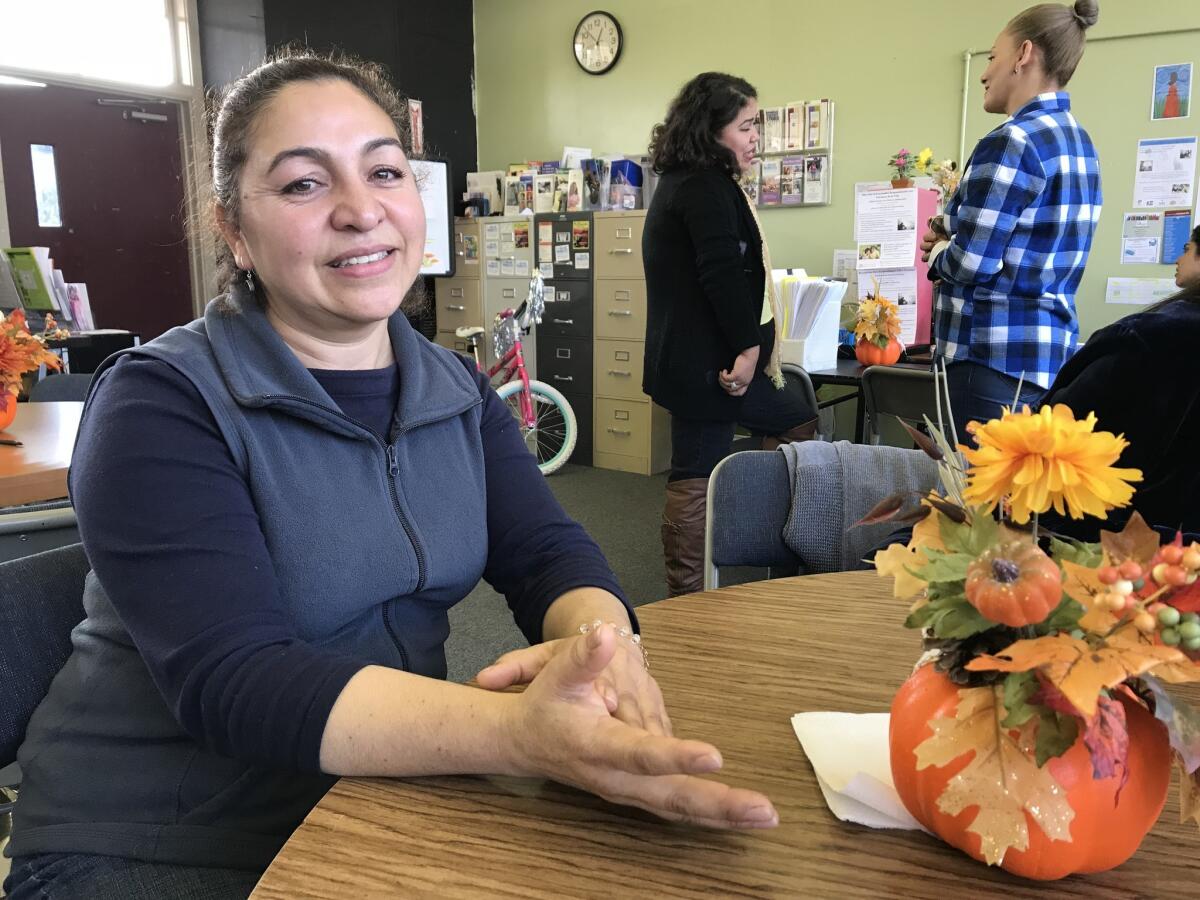California Journal: In Northern California, forgotten victims of the wildfires struggle to regain their footing

- Share via
Reporting from Napa, Calif. — Claudia and Francisco Alvarez had what they thought was a perfect situation in the mountains west of Calistoga in Napa County.
For several years, they worked and lived on the grounds of a rustic guest ranch with their two children, Steven, 7, and Sofia, 4. Claudia was in charge of housekeeping for 18 cottages. Francisco was in charge of maintenance.
They rented a three-bedroom house on the ranch property at a discount, and their employer was flexible, allowing Francisco time to drive Steven off the mountain to school in Santa Rosa, about half an hour away, and to pick him up each afternoon.
The fires that swept through wine country in October destroyed all that. Mountain Home Ranch, a 100-year-old resort, burned to the ground. In one devastating night, the Alvarez family’s home and jobs went up in smoke. On Wednesday, Claudia wept as she told me about their harrowing escape.
Her husband had left their house to wake up the ranch’s sleeping guests. When she walked outside and saw the mountain on fire with the wind whipping embers and smoke through the air, she panicked. “I started screaming and yelling. It was really bad. Things happened really fast,” she said through tears. “I wanted to save my kids.”
With nothing but the clothes on their backs, the family fled in their 1998 Honda CR-V to the Santa Rosa home of Claudia’s sister. Several hours later, they had to flee again, as the fire claimed her sister’s house in the Coffey Park neighborhood, which was destroyed.
The Alvarez family ended up spending two months in the living room of relatives in Rohnert Park before Claudia found help at UpValley Family Centers, a nonprofit resource organization and social safety net devoted to helping low-income, mostly immigrant families.
“We provided them emergency financial assistance in the form of funds to purchase new beds, as well as gift cards for items for their new apartment,” said Jenny Ocon, executive director of the organization, which helped more than 400 immigrant families after the fire. “We helped them pay their security deposit and first month rent, too.”
Just last week, the Alvarez family moved into a modest three-bedroom town home in Cotati, south of Santa Rosa. Their 2-year-old German shepherd, Luna, remains in a shelter. Families at Steven’s school, Austin Creek Elementary in Santa Rosa, have showered the family with gift cards, which Claudia said will help brighten what was looking like a dim Christmas for the children.
“Getting help from people who don’t know me makes me very surprised and very thankful,” she said. “Having people knocking on your door and saying ‘I wanted to help you’ makes me feel blessed and surprised and embarrassed.”
For now, Francisco is earning money working with a friend who has a concrete business. Claudia is too traumatized to look for work.
“Even if you want to start a job, you need to have your brain clear, you need to be mentally strong,” she said. “I am not feeling strong enough yet.”
::
For a while after the October wildfires, people thought Napa Valley, renowned for its wineries and tourism, would bounce right back. It wasn’t hit as hard as Sonoma and Mendocino counties. Of the 600 homes that were lost here, as many as 45% were second homes.
But recovery has been slower than anticipated.
An almost-invisible class of people in the agriculture and hospitality industries has been hurt.
“Napa is a tale of two cities,” said Terence Mulligan, president of the Napa Valley Community Foundation, which distributes funds to local groups like UpValley Family Centers. There are very wealthy people, who are generally white, he said, and very poor people, who are generally Latino. “Up to 15,000 people in this county of 140,000 live paycheck to paycheck, hand to mouth, and don’t have a cushion.”
About 11,000 of those, he estimates, are undocumented.
A first wave of immigrants affected by the fires showed up immediately at places such as UpValley Family Centers or On the Move, which serves clients at the southern end of Napa Valley. But now, said On the Move executive director Alissa Abdo, a second wave is coming through her door, workers affected by the tourism decline.
“Some people were able to glue it together for a couple months, but are now reaching a point where they are not able to pay the rent and are being evicted,” she said.
::
I was thinking about the fires’ different kinds of victims the other day in Santa Rosa, where I met a man who lost his spacious hilltop home in October.
He told me his insurance company has given him a million dollars to cover the loss of his belongings and an additional $1.3 million to rebuild. He could not complain, he said, and was grateful that his family and pets were alive.
His concern now is trying to figure out how to keep his business running and rebuild his home. Both, he said, are more than full-time jobs.

It’s a completely different kind of problem than the one facing Beatriz Calderon, 43, a mother of two, whom I met at one of On the Move’s resource centers, located in an elementary school in a mixed-income Napa neighborhood that is home to many immigrants. Calderon’s husband worked at a winery that burned down. Their home was untouched, but her husband lost more than a week’s pay, which put them perilously behind on their bills.
She would like to find a job but must care for her children, who are 11 and 8. She worries that her English is not good enough. “Maybe I can clean someone’s home,” she said. “We haven’t been able to buy a Christmas tree this year, but we don’t want the children to know how hard it is.”
After the fire, the family borrowed money from friends to cover their $1,275 monthly rent, but they had nothing left for their phone and utility bills. Also, their landlord is requiring them to buy renters’ insurance. “We can’t afford that,” Calderon told me. On the Move, which spends up to $1,500 in emergency funds per client, was able to pay her bills and help her family regain its footing.
In the grand scheme of things, it isn’t much. But for families like the Calderons and the Alvarezes — and other invisible victims of this season’s wildfires — it makes a world of difference.
Twitter: @AbcarianLAT
More to Read
Sign up for Essential California
The most important California stories and recommendations in your inbox every morning.
You may occasionally receive promotional content from the Los Angeles Times.










